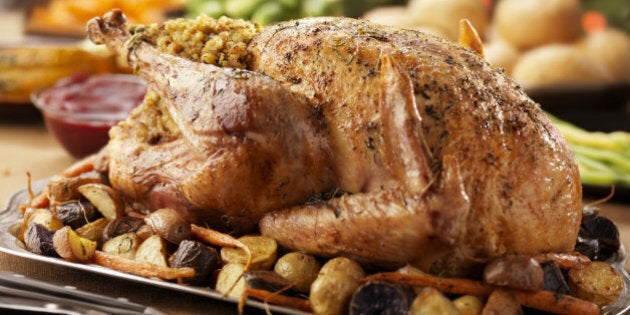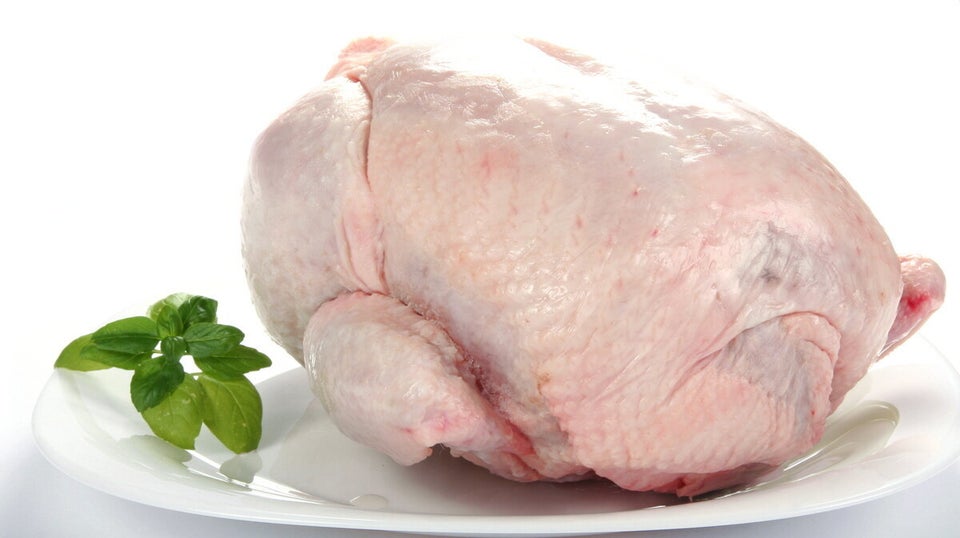
Roast turkey is a meal that most of us only cook a couple of times a year, if at all, so it can be stressful when you've got holiday dinner looming over your head. Add in the pressure of hosting family, keeping up cherished traditions, and competing with your aunt's famous stuffing recipe, and it's enough to make even the best home cooks nervous.
If the task of providing the holiday bird falls to you this year, you'll want to read our 17 tips for the perfect roast turkey — or a suitable alternative, if going that route won't cause an irreparable family rift.
Fresh or Frozen? When it comes to buying a bird, you have two options: you can buy one fresh, which will never have been frozen, or buy one frozen and defrost it before you cook it. What's Cooking Americaadvises going with frozen — because it will have been frozen immediately, the meat might actually be fresher than a never-frozen bird. If you do want to go with fresh—or need to, because of time constraints—get one that hasn't been sitting out for a couple of days already.
Choose the Right Size Bird: Martha Stewart — and she should know — advises to plan for 1.5 pounds of meat per person, though she points out that turkeys that are 12 pounds or less will have a smaller meat-to-bone ratio; if you have a smaller turkey, go with two pounds per person as your guideline. And if you're not sure, why not err on the high side? Then you'll have leftovers! More on what to do with those later.
If you have a big crowd coming, you might want to cook two smaller turkeys instead of one large one. Fine Cooking suggests that the two smaller birds will fit better in roasting pans and the fridge, and cook both more quickly and evenly.
Defrost Safely: It's not safe to defrost on the counter, especially considering the length of time it takes to properly defrost a whole turkey. Counter defrosting gives harmful food-borne bacteria the chance to grow, which means you're risking giving food poisoning to your guests. At best, that makes for a very unpleasant holiday; at worst, it can lead to serious illness or even death. The Food Network recommends defrosting your turkey in the fridge, allowing four to five days to fully defrost a 20-pound bird; Martha Stewart says to allow for a full day of defrosting for every four pounds, and points out that you should put the bird on your bottom shelf of the fridge, so you don't get raw turkey drippings on other food.
Should You Brine? Some turkeys, including kosher turkeys and commercial brands like Butterball, come pre-brined, so you won't need to bother. Serious Eats recommends brining if you are buying a bird that isn't pre-brined. Reader's Digest says you can use a dry rub of kosher salt, dried herbs, and pepper if you want to avoid brining — rub on the night before you plan to roast. ABC News says to go with two cups of kosher salt for two gallons of water for brining, with the optional addition of two cups of sugar and spices of your choosing.
Get Crispy Skin: The Food Network advises that unwrapping your turkey the day before roasting and leaving it uncovered in the refrigerator overnight will make the skin crispier when you roast it. Coating the skin with oil or melted butter helps as well. Jamie Oliver recommends shoving pats of butter, along with fresh herbs, under the skin for great crispiness and flavour. And Reader's Digest suggests browning the turkey skin with white vermouth about 15 minutes before you plan to take it out of the oven, as a means to get a darker skin.
Get That Turkey Clean: First of all, if the giblets are inside the turkey, take them out — you don't want to be roasting a plastic bag. Keep them, though, for gravy. You can rinse your thawed turkey with cool running water, and dry it inside and out with paper towels, which will help your skin crisp. But the U.S. Department of Agriculture advises not to rinse, as doing so risks contaminating the sink and surrounding area with bacteria. So if you do go with rinsing, clean the affected area well afterwards.
Cook for the Right Amount of Time: Yes, you're cooking an unfrozen bird either way, but the time you need to allow for roasting depends on whether or not you bought your bird frozen or fresh. If your turkey was purchased frozen and has been defrosted, allow for 20 minutes of cooking time per pound, at 350 degrees F. If you're starting with a fresh turkey, you'll have to allow 10 to 15 minutes per pound.
Do the Stuffing Right: It sounds like sacrilege, but Martha Suggests cooking your stuffing in a separate pan instead of inside your turkey. You might lose out on some flavour, but you will cut the risk of bacteria exposure. If you must stuff the turkey, do it right before it goes in the oven so bacteria doesn't get the chance to multiply; Reader's Digest suggests wrapping your stuffing in cheesecloth before shoving it in the turkey cavity, which keeps it from sticking to the insides and also makes it easy to remove. The Food Network advises that an unstuffed or loosely stuffed turkey will cook more evenly, and suggests trying aromatic veggies like carrots and celery as stuffing instead of the traditional bread-based option.
Pick the Correct Pan: You'll need a roasting pan with a rack to really cook your turkey properly—the rack allows the oven heat to circulate properly and helps the bird brown well. What's Cooking America says to get a shallow pan, because you risk steaming the meat with a deeper one. Also, if you're buying a new pan, consider one with handles: it'll make it a lot easier to get a heavy bird in a hot pan out of the oven without burning yourself or dropping it. If you don't have a rack and it's too late to get one, improvise by making one with criss-crossed carrots and celery. As a bonus, you'll get extra flavour for your gravy in the pan drippings.
Leave The Oven Door Closed! Yes, it's tempting to check on your dinner, and the smell of roasting turkey that fills the kitchen when you open the door for a peep can up the anticipation for the final product. But hold off and keep that oven door shut — the Food Network advises that opening the door causes the oven temperature to fluctuate, which can dry out your meat. Martha Stewart takes the opposite position, saying that you should regularly baste your turkey with its juices as it roasts, after the first hour in the oven has passed. And Rachel Ray suggests to baste with melted butter and wine instead of the turkey juices.
Cook to the Right Internal Temperature: Sure, you defrosted your turkey safely, but you also have to make sure you cook your bird fully. Get a meat thermometer (don't rely on the little plastic one that comes with the turkey) and check the temperature — your turkey is done when the thigh meat is at 165 degrees F. If you stuffed your bird, check the internal cavity as well; it too should be 165 degrees or higher.
Give It a Few Minutes to Sit: You'll probably want to carve the turkey as soon as it's out of the oven, and you might get some extra pressure to do so from impatient guests. But it's best to let it sit for 20 or 30 minutes; this gives the meat a chance to reabsorb the juices, resulting in a moister turkey. Loosely tent the turkey with aluminum foil before you let it sit; it'll help it retain its heat.
Carve It Properly: You'll want a sharp knife or electric knife to carve your turkey properly. Start by taking out the stuffing, then removing the legs, wings, and breast meat in that order. Canadian Living has a helpful visual guide to the process.
Tofurkey: Not feeling the meat, or looking for an alternative for vegetarian or vegan guests? You could pick up a Tofurkey (http://www.tofurky.com/), which comes complete with stuffing. It's an acquired taste for some, but it's nice to have an option for the non-carnivores.
Deep Frying: If roasting is not for you, give deep frying a try with a special turkey deep fryer. Butterball recommends sticking with turkeys that are 12 pounds or less for deep frying, and cooking your turkey for about 3 to 4 minutes per pound. (http://www.butterball.com/tips-how-tos/how-tos/deep-fry) The end result is meat that's particularly moist and tender. However, with this method you'll need to cook stuffing separately, and make gravy with pre-existing broth because you won't have turkey drippings. Paula Deen has a recipe, of course.
Grilling: You could also give the barbecue one more go for the season and grill your turkey. You'll want a charcoal grill for this one, and 25 to 30 briquettes, or a gas grill that allows for at least an inch of space between the top of the turkey and the lid. Butterball has detailed instructions for this approach—they advise that a 10- to 18-pound turkey will take two to three hours in the grill to cook through. You could also try a smoked turkey.
Leftovers: What to do with the inevitable leftovers? There's always hot turkey sandwiches, which are a classic for a reason. Leftover meat can form the basis for a nice soup, especially if you keep the carcass to make a homemade turkey stock. Repurpose your favourite chicken salad recipe by using turkey instead. Or put shredded leftover meat to good use in tacos or quesadillas.
If you do plan to save meat for leftovers, don't dilly dally on it: the Louisiana State University Agriculture Center advises that you've got two hours from the time you take the turkey out of the oven to safely serve and refrigerate or freeze your leftovers, including for the stuffing and gravy.
